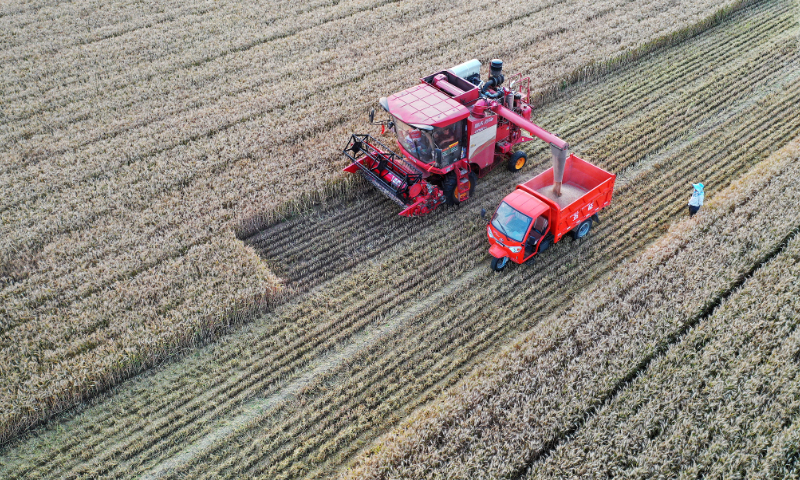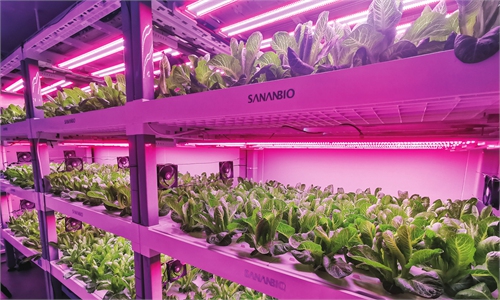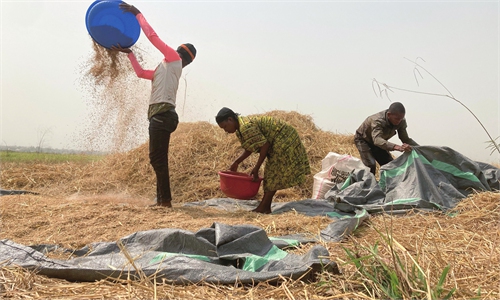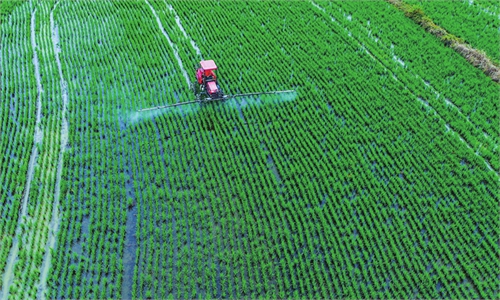China steps up efforts to protect 'granary' amid extreme weather
Swift measures to ensure food security despite external risks

A farmer is operating a large combine harvester to harvest wheat in the fields in Zaozhuang, Shandong Province on June 9, 2023. Photo: VCG
Chinese farmers and analysts said on Wednesday that while the country's Northeast region, which accounts for more than one-fifth of the national grain production and is known as "China's granary," recently suffered from severe rainstorms and flooding, the impact on overall grain production will likely be limited, dismissing foreign media hype of potential "widespread crop failures."
Recent extreme weather in some parts of China has raised concerns about food supply. However, the country is well-equipped to mitigate the impact of extreme weather on its grain market, thanks to the Chinese government's unwavering focus on food security in recent years, farmers and analysts said. Extreme weather has become frequent in the summer season, but this year's impact will not be so extreme as in previous years, they said.
This proactive approach, coupled with the government's top-down proactive coordination to swiftly implement relief measures, has enabled China to maintain stable grain prices within a reasonable range.
Limited impact
From central to local levels, China is actively implementing post-disaster recovery plans to safeguard food security and supporting affected areas to restore agricultural production.
In a fresh move, the Ministry of Finance and the Ministry of Water Resources on Wednesday urgently allocated 1 billion yuan ($138 million) in compensation for damage to crops, livestock breeding, forestry, housing, and agricultural machinery belonging to people living in flood detention regions, to help them quickly restore normal production.
More relief efforts could be underway. On Wednesday, Minister of Agriculture and Rural Affairs Tang Renjian presided over a special meeting to further study and promote agricultural disaster relief and autumn grain production, stressing the need for further efforts on disaster relief in affected areas and reduce losses. The meeting called for all-out efforts to increase yield to make up for the losses.
An executive meeting of China's State Council on Tuesday mapped out further measures to rescue crops amid torrential rainstorms and floods. The meeting urged the prompt restoration of damaged farmland and agricultural facilities, increased supply of agricultural materials, and more credit support for affected areas, especially for small and individual businesses and farmers.
The Ministry of Finance and the Ministry of Agriculture and Rural Affairs on Tuesday allocated disaster relief funds totaling 732 million yuan ($102.3 million) to support the recovery of agricultural production.
The funds are intended to be used for urgent agricultural flood control and disaster relief work, and to support post-disaster agricultural production, according to a statement on the Finance Ministry's website.
Appropriate subsidies will be applied to purchases of agricultural materials such as seeds, seedlings, fertilizers, pesticides and operational services to resume agricultural production, and to repairs of damaged agricultural production facilities, it said.
At a local level, agricultural authorities in Heilongjiang Province issued a disaster relief plan to ensure that this year's grain production meets the target. Efforts are being made to drain water from the fields, strengthen field management and prevent and control pests and diseases.
Heilongjiang has been China's top grain producer for 13 consecutive years. In 2022, total grain output in Heilongjiang Province reached 155.26 billion jin (77.63 billion kilograms), the second-highest in history, accounting for 11.3 percent of the national total, official data showed.
Some farmers in Heilongjiang told the Global Times that although the rainfall may cause some short-term reductions in rice crops, foreign media hype about potential widespread crop failures led by the flood and the "severe impact" on China's agricultural production are overly exaggerated.
"Due to higher terrain, our crops weren't flooded too much. The situation in our village isn't as serious as certain media have hyped," Yang Lei, head of a farmers' cooperative that plants paddy rice in Wuchang, Northeast China's Heilongjiang Province, told the Global Times on Wednesday.
Wuchang city is one of the top five rice-producing areas in China, renowned for its abundant harvests.
Yang said that his cooperative plants around 1,000 mu (66.67 hectares) of paddy rice, of which about 100 mu was impacted by the heavy rain, but the floodwater subsided within 24-36 hours.
"As it's the key flowering period for paddy rice, being flooded will reduce the harvest but it's not a total failure," he said, refuting rumors that claimed the heavy rain will cause a total rice harvest failure in Wuchang city.
Li Shihua, another farmer based in Harbin, Heilongjiang Province, told the Global Times on Wednesday the heavy rain affected only part of the city and his crops were not impacted.
Thanks to the government's favorable policies and subsidies to encourage planting, Li Shihua said that he contracted approximately 10,000 mu of land for planting soybeans and corn this year, a significant rise compared with the land he contracted last year. He has insurance to compensate for crop losses.
In Northeast China, there is limited amount of farmland that will post total failure this autumn due to the impact of the heavy rain and flooding, as the country has relatively sound preparations for extreme weathers, Li Guoxiang, a researcher at the Rural Development Institute of the Chinese Academy of Social Sciences, told the Global Times on Wednesday.
Additionally, China has been taking active approaches to deal with natural disasters, with stepped up cultivation of high-standard farmland and strengthened water conservancy establishment, and all these efforts will hedge the impact of grain production in some regions, he said.
"Currently, the urgent task is draining away the water in lower terrains and planting other crops with short cycles so farmers can produce some harvest in October. On the other hand, more technologies should be adopted, for example, detecting water content in farmland and conducting pest control, for better growth of crops," he said.
Focus on food security
In light of recent attempts by foreign media to hype China's food security situation, recent data showed that market supply and prices remain stable. Experts believe the country has strong coordinating capabilities and reserves to ensure China's long-term food security.
Summer grain output totaled 146.13 million tons this year, down 0.9 percent or 1.27 million tons from a year ago. Yet it is still at a relatively high level, achieving a bumper harvest, official data showed.
Despite the extreme weather conditions in grain producing areas and the export bans on rice by multiple countries, overall grain prices in China have remained stable and within a reasonable range.
According to data from the Ministry of Commerce, as of the end of July, the retail price of small-packaged rice was 6.67 yuan per kilogram, a decrease of 0.89 percent compared to the beginning of the year.
Although extreme weather also has some impact on China's agriculture sector, the impact is limited thanks to the country's comprehensive agricultural infrastructure and sufficient grain supply, Li Guoxiang said.
China is leading at an international level in both grain reserves and storage which has ensured "absolute food security" for the nation, officials from the National Food and Strategic Reserves Administration told a press conference in May.
The per capita grain for Chinese people stands at approximately 480 kilograms, surpassing the internationally recognized food security threshold of 400 kilograms, according to the administration.
The country boasts storage capacity of nearly 700 million tons in standard grain warehouses, relatively advanced on a global scale, according to the administration.
Experts said that extreme weather occurs every year, along with other special circumstances. Though it remains challenging, this year is not considered the most extreme in history.
Despite both natural disasters and an energy crunch in 2022, China's grain output still surpassed 1.3 trillion jin (650 billion kilograms) for eight consecutive years, providing a "better, stronger and more stable rice bowl" for 1.4 billion Chinese, according to China's agriculture department.





